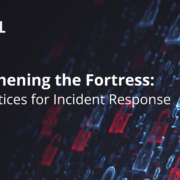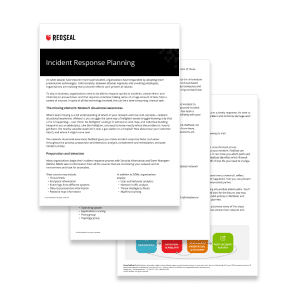Strengthening the Fortress: Best Practices for Incident Response
As the digital age continues to see rapid change, cyber threat looms over businesses, organizations, and individuals even more than before. And, as technology advances, so do the capabilities of cybercriminals. With today’s digital environment, more than ever before, crafting a robust cybersecurity incident response plan isn’t a recommendation—it’s a critical necessity.
What does this mean? It’s a matter of when—not if—a network is compromised. Companies can no longer assume that security frameworks offer invincibility from evolving cyberattack trends. Instead, businesses need a strong incident response program designed to help them quickly react—and in the worst-case scenario come out stronger on the other side.
Designing a sophisticated incident response framework
A cybersecurity incident response plan establishes a structured framework for teams to adhere to when facing a cyber incident or attack. As defined by Gartner, a cyber incident response plan is “formulated by an enterprise to respond to potentially catastrophic, computer-related incidents, such as viruses or hacker attacks.” Gartner research extends to projections for 2026, suggesting that organizations invest at least 20% of security funds in resilience and flexible programs to halve their recovery time.
In crafting a cybersecurity incident response plan tailored to the specific needs of your organization, key considerations and common components include:
1. Defining objectives and scope. Objectives could include, but aren’t limited to:
- Impact minimization
- Business continuity
- Protecting sensitive information
- Regulatory compliance
- Identifying and understanding threats
- Outline for timely recovery
- Response efforts
- Future improvements for cybersecurity posture
- Post-incident analysis
2. Establishing an Incident Response Team (IRT). Assemble a dedicated team responsible for executing the response plan. The team should be comprised of members of the organization from IT, security, legal, communications, and any other relevant business teams. Roles and responsibilities should be clearly identified to ensure a coordinated and timely response.
3. Developing an incident classification system with procedures. A system for classifying incidents based on severity and impact can help guide the response process and help the IRT prioritize actions. We recommend creating a detailed response playbook with step-by-step guidance for various incidences can help a team contain and recover from the incident effectively and efficiently. Playbook should include communication procedures to ensure employees and appropriate external stakeholders are notified.
4. Implementing incident detection and reporting. Employing an effective detection and reporting system is critical for early identification and response to a cybersecurity incident. Examples include, but are not limited to:
- Endpoint protection
- Firewall and network monitoring
- Email security systems
- Security and awareness training for employees
5. Conducting regular training and simulation. Training for the incident response team should be set up regularly through simulations and exercises. Each month, RedSeal hosts a Cyber Threat Hunting Workshop. Through our workshop, you will use the RedSeal platform and threat hunt within a pre-built virtual network model. You’ll assess the network’s overall cybersecurity posture while refining your skills in risk and vulnerability assessment, cyber hunting, and incident response. At the completion of the session, you will have learned how to:
- Identify potential attack vectors that bad actors could use to exploit existing vulnerabilities
- Optimize resources by leveraging risk-based vulnerability prioritization
- Easily identify devices on the network that pose the most risk to your enterprise—those with network access and exploitable vulnerabilities
- Quickly visualize where bad actors can pivot following system compromise and traverse a network
- Coordinate with other teams to minimize the impact of an event while enhancing your organization’s digital resilience
- Use network context to develop mitigation strategies and implement your run-book plays
Preventing unauthorized access into, out of, or within a network requires understanding how that network is built– a difficult, tedious, and time-consuming task.
6. Post-incident analysis. Outline and conduct a comprehensive post-incident analysis to understand the root causes of the breach and to identify areas in need of improvement. Lessons should be documented, and the incident response plan should be updated accordingly.
Designing a robust incident response plan is just the tip of the iceberg.
The most important aspect of incident response could be what comes next—evaluation and improvement. Cybersecurity resilience requires constant monitoring and evolution. Regular updates and adaptions to the plan are imperative to effectively address the ever-evolving landscape of cyber threats. The journey to securing your network for good is an ongoing process, demanding an unwavering commitment to visibility, refinement, and optimization. At RedSeal, we’re committed to helping you fortify your digital infrastructure, for good. We proactively help visualize your network, identify attack paths, prioritize risk, and help you stay in compliance to ensure your business and customers stay secure.
Interested in learning more?
Download our in-depth look into incident response planning today!




